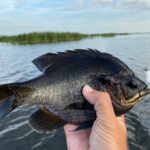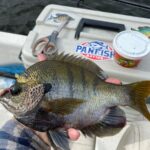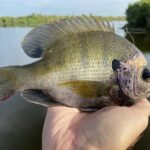It goes without saying that regular catfish are good to eat…but can you eat armored catfish?
What about those spikes on their skin? How do you catch them and clean them? Do they taste good?
Well…the answer may really surprise you!
Table of Contents
Can You Eat Armored Catfish
Despite their sharp bony exterior and menacing looks, you can eat armored catfish. They are a common food source in their native range, and although they can be difficult to clean, the meat is considered mild and flavorful.
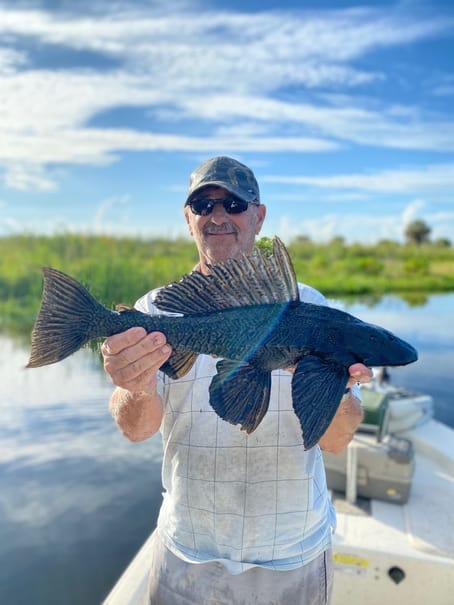
There are two main types of armored catfish invasive to North America: the Sailfin Catfish (Pterygoplichthys sp.) also known as the “Pleco” and the Brown Hoplo (Hoplosternun littorale) also known as the “Hoplo“.
Are Armored Catfish Good To Eat?
Armored catfish are supposedly very good to eat! In their native regions, armored catfish are commonly caught, sold at local fish markets, and eaten.
The Brown Hoplo is known as Hassa by the West Indian community. They are often cooked in curry and eaten with rice.
The Sailfin catfish or Pleco is known as the Moqueca in Brazil. They are often cooked ‘in the shell’ on the grill.
Are Armored Catfish Poisonous to Eat?
Armored catfish are not poisonous. They do have sharp spines, but they do not have any venom or poison whatsoever.
Catfish are naturally very hardy species, and they can survive in polluted, eurotrophic, and anoxic waters.
For this reason, you should avoid consuming armored catfish from polluted areas as it may affect taste and texture.
But rest assured, armored catfish are not poisonous or venomous.
What do Armored Catfish Taste Like?
Armored catfish are said to have white, flakey meat with a sweet flavor. It’s not fishy, but they can have a dirty taste, if not cleaned thoroughly.
How to Clean Armored Catfish?
Armored catfish should be cooked in the shell, so they have a very unique cleaning process. Armored catfish are bottom feeders and collect a lot of dirt and mud on their exterior, and this cleaning process gets rid of the muddy flavor.
Step 1
Cut off the fins and whiskers of the fish. These have no meat and can be discarded.
Step 2
Cut open the belly. Rinse the inside and remove the guts. Wash away any remaining blood or innards.
Step 3
Rub the fish, inside and outside, with salt, and let it sit for an hour to hour and a half. This is done to leech away any muddy flavor.
After about an hour, wash away all the salt. Make sure you get the insides too.
Step 4
Cover the fish with flour and add some lemon juice. Let it sit for about 5 minutes. Then rinse all the flour and lemon juice off, and your catfish are ready to cook.
How to Cook Armored Catfish?
Cooking armored catfish is very different from cooking other fish because they have a hard outer skin, almost like a shell!
They are best cooked with their shell on and for that reason cooking armored catfish is more similar to cooking a lobster than fish.
You can cook armored catfish a number of ways, but the most popular way to cook brown hoplo (Hassa) is in a coconut curry.
You can also have armored catfish grilled or baked. It is said that Pleco are best eaten when cooked in a half shell.
Where To Catch Armored Catfish In Florida
Both the Sailfin Catfish and Brown Hoplo prefer slow-moving rivers, lakes, and swampy areas. They can tolerate very low levels of oxygen.
Strong populations of armored catfish have been documented in the Everglades ecosystem, the Kissimmee chain of lakes, and the St. Johns River.
Small residential ponds, canals and drainage systems are typical hotspots for armored catfish.
How To Catch Armored Catfish
Because the Brown Hoplo and Sailfin Catfish (Pleco) are invasive, so there is no size, season or bag limit. Therefore the easiest way to catch them (and catch a lot of them) is with a cast net.
They can often be seen along the bank edge, or coming up to the surface to gulp for air. Focus on fishing in areas that have muddy bottom sediment, or along rocky banks or cement spillways.
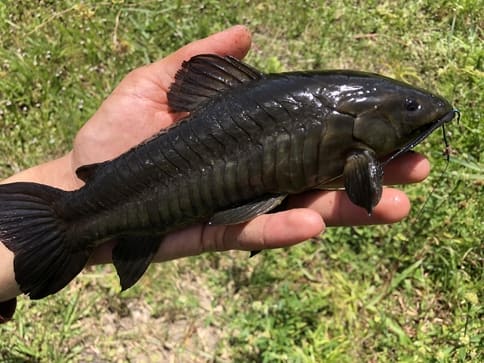
Both species of armored catfish are most active at dawn and dusk.
If you want to target them on rod and reel, try using a small piece of worm as bait, fished on the bottom with a #1 circle hook.
What Do Armored Catfish Eat?
Both species of armored catfish feed on detritus, algae, and benthic invertebrates.
They use their small mouths to search along the bottom, along rocks, and submerged logs to find worms, water fleas, and aquatic vegetation.
Frequently Asked Questions
Why are armored catfish a problem?
Armored catfish are invasive in North America and cause a lot of damage to natural habitat and native species.
They eat native plants, increase erosion, and they even harass manatees. In introduced regions, armored catfish have few natural predators in the wild, so their populations grow fast.
How big do armored catfish get?
Brown hoplo are small, and they are usually less than 12 inches. Sailfin Catfish, commonly known as Pleco, can reach over 20 inches!
Why do Armored Catfish go on Land?
Armored catfish have the ability to breathe air! Whenever water levels are high, after periods of intense rain and flooding, they have the ability to move between water bodies. To the opposite effect, if water is really low, they may get stuck on land as water levels fall.
Where Do Armored Catfish Live?
Armored catfish are native to the eastern countries of South America, such as Brazil and the Guianas. In their native range, they are valued as a food source.
Non-native populations of Pleco’s and Hoplos have been established in central and south Florida, most likely as the result of released pets, or escapes from the aquaculture industry.
You May Also Like: Can You Eat Gar fish? (Results May Surprise You!)
If you haven’t guessed yet, I love fishing and everything about it!
To learn more about why I started Panfish Nation, visit the About page and follow along on Social Media:


Download a copy of my FREE Lure Color Selection Chart & Knot Guide!
Stay up to date with fishing reports, tackle reviews, industry news, and much more! We respect your privacy, unsubscribe at any time.
Related Posts
- Crazy Facts About the World Record Crappie
- What Size Hooks for Smallmouth Bass? Quick Guide
- Large and in Charge-Mouth: 10 of the Best Bass Lures of All Time (And Where to Buy Them)
- Emperor of the Sun(fish): What You Need to Know About the World Record Bluegill
- Coppernose Bluegills: How They’re Different from Common Bluegill
- Bluegill vs Brim: Differences & Terminology, Explained!




